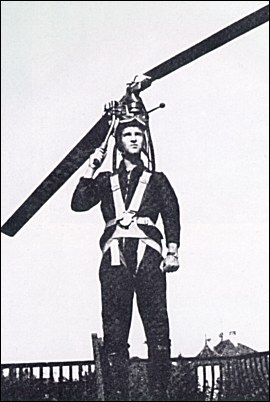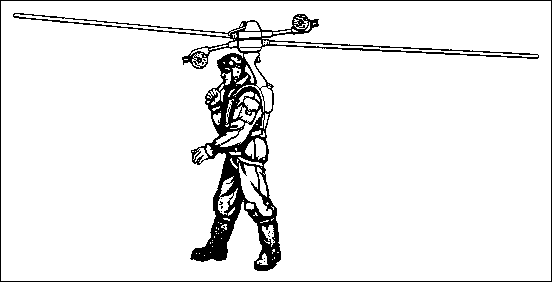Paul Baumgartl started tinkering with the idea in the mid-1930s. What he originally saw as a toy for wealthy sportsmen evolved into a revolutionary transportation gimmick for the German Army. The concept was to strap a miniature helicopter onto an infantryman's back, making the German supersoldier able to leap tall buildings in a single bound. The first version (Heliofly I) was built and ready for testing in 1941:

With no tail rotor or counterweight to offset the torque of the spinning rotor blades, the device amounted to little more than an autogyro glider that would slow the pilot's (aka the impending casualty's) descent to a very hard landing. Any sudden increase in throttle would've sent the pilot spinning around the shaft in the opposite direction of the rotors. In effect, Baumgartl had developed a flying, twirling, vomit sprinkler.
The improved version conceived for military use consisted of a pair of rotor blades that would rotate in opposite directions around a common vertical shaft. Each rotor was independantly powered by a small engine that would also rotate around the shaft and act as a counterweight against the rotor blade. The notion was that this would make for a smoother, less dizzying ride.
Here's a couple of diagrams:


The problem though was that even with the improved counter-rotating design, flying it required an exceptionally strong pilot to wrestle the aircraft into submission. Supposing you could find the right kind of manpower, the learning curve for training them was pretty steep too.
When you add in the excessive per-unit cost of these devices, the Reich decided it made more sense to invest its dwindling resources into proven effective weapons and vehicles. Even if the Wehrmacht had decided to assemble a heliborne division, the slow airspeed would've made them exceptionally easy target for the bewildered Allied troops that met them on the battlefield.
While a strap-on helicopter may not have been good enough for Hitler, I still want one. The good news for me is that they're actually on the "things I can have" horizon. Weighing in at 165 pounds, the world's smallest helicopter is the GEN-H4, invented by Japanese rotorhead Gennai Yanagisawa. The prototype has been making the rounds giving demonstration flights:

By my way of thinking, the landing gear is a bit of a cop-out when it comes to strap-on helicopters though. I guess I'll just have to wait a few more years before some other Japanese guy figures out how to make the whole thing smaller.
Really it's only a matter of time.

"With no tail rotor or counterweight to offset the torque of the spinning rotor blades, the device amounted to little more than an autogyro glider that would slow the pilot's (aka the impending casualty's) descent to a very hard landing. Any sudden increase in throttle would've sent the pilot spinning around the shaft in the opposite direction of the rotors. In effect, Baumgartl had developed a flying, twirling, vomit sprinkler." - the first version was an autogyro glider and as such needed no tail rotor like all autogyros. It had no engine so had no torgue.
ReplyDeleteThe second version, III/57, never actually flew and the third version, III/59, was a pretty conventional light-weight helicopter.
dl
ReplyDelete